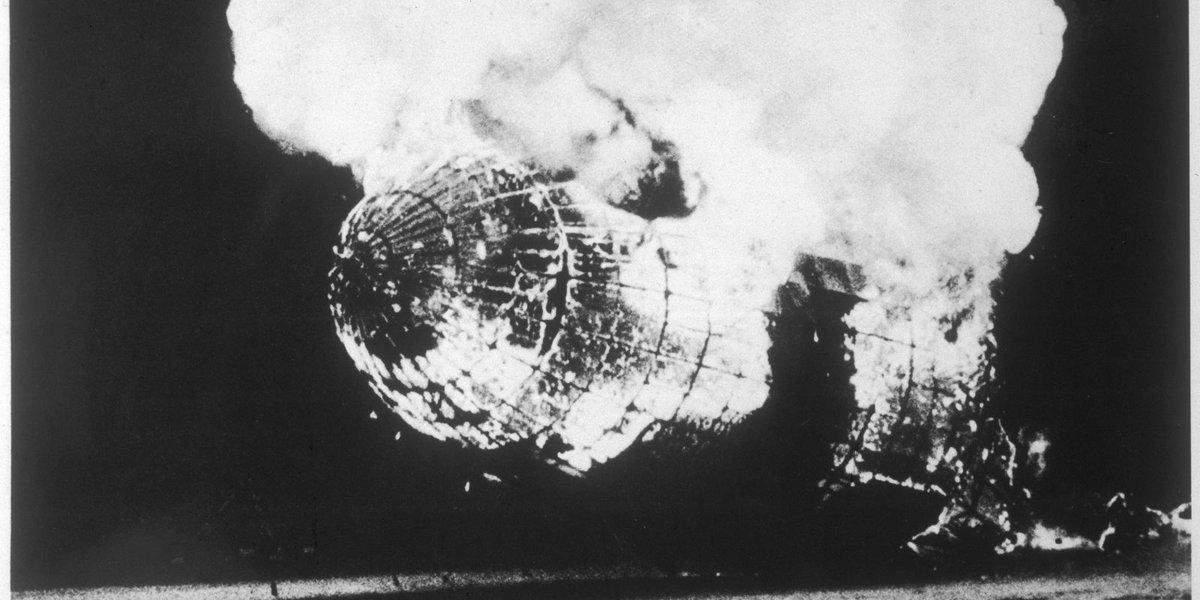WHERE DID THE HINDENBURG CRASH?

Advertisement
It all started May 6, 1937, the day of the Hindenburg Disaster. You might be asking, "Where did the Hindenburg crash?" Many people assume it was somewhere or Germany, or at least, far far away from the U.S. Well, it just so happened to crash in Manchester Township, New Jersey, directly over Joint Base McGuire-Dix-Lakehurst.
Read next: The Army’s NetModX Is Advancing Aerial Communications at JBMDL
When and Where Did the Hindenburg Crash?
The Hindenburg was extremely impressive for how fast and far it could travel. Have you ever asked yourself, "How far did the Hindenburg fly?" To give you an idea of just how far this ship can travel in general, Britannica notes that "In 1936 the Hindenburg inaugurated commercial air service across the North Atlantic by carrying 1,002 passengers on 10 scheduled round trips between Germany and the United States." Overall, those trips accounted for 191,583 miles. An impressive feat! During the second half of its 1937 transatlantic crossing, the Hindenburg crashed in Lakehurst, New Jersey. Interestingly enough, at the time of the disaster, the Hindenburg crashed directly over Lakehurst before Joint Base McGuire-Dix-Lakehurst was merged. The crash site can still be seen on the base. To this day, members and faculty at Joint Base McGuire-Dix-Lakehurst continue to memorialize the 36 people who passed away at the Hindenburg crash site. The disaster claimed the lives of many passengers and crew members, including air and ground crew members who assisted in the landing process.Hindenburg Crash Site
The Lakehurst Hindenburg crash site continues to be on an active Navy base directly where it crashed. Anyone who wants to visit the site, given they aren't in the Navy, will have to be screened days before. The site consists of the LZ 129 Hindenburg outline with a thick anchor chain. Staked in the ground is a metal silhouette of the Zeppelin upon it that turns with the wind.Advertisement
Did Anyone Survive the Hindenburg?
How many people died in the Hindenburg crash? According to the History Channel, approximately 36 people died, 13 of them being passengers and 22 of them being crewmembers. A total of 97 passengers and crew members were aboard the ship, and out of 97 of them, 61 were Hindenburg survivors. Many of the individuals who survived the disaster jumped from the windows before running for their lives as the Zeppelin fell from the sky.Inside the Hindenburg
The interior consisted of 3 primary sections, according to Airships.net. These included the passenger decks, control cars, and crew areas. Inside the decks were full-fledged dining rooms, passenger cabins, a lounge, and a writing room. Not to mention, the Hindenburg was fully equipped with promenades, a smoking room (a questionable choice for a hydrogen airship), and even a bar. The dining rooms were 47 feet in length by 13 feet in width. There were multiple dining tables and chairs for passengers to dine, and on the walls were beautiful paintings of the Graf Zeppelin during flights in South America. The passenger lounge was 34 feet long and had a large decorated mural of ships and routes from explorer Ferdinand Magellan. Next was the writing room, which, compared to the lounge, was considerably smaller and consisted of paintings from around the world. Each cabin was equipped with a call button to get help, and none of the cabins had a restroom. Nonetheless, the Hindenburg was vast and had plenty of amenities for guests and crewmembers to enjoy. On the ship was highly flammable hydrogen, as reported by USA Today. Initially, the ship was meant to be filled with helium gas, but during the time of the crash, the U.S. had restrictions on helium. Having a highly flammable natural gas onboard like hydrogen didn't necessarily blow the ship up, but it did cause the vessel to catch fire easily and abundantly.Why Did the Hindenburg Explode?
So, what happened to the Hindenburg? Research from the History Channel shows that the U.S. government concluded that it was due to an electrical phenomenon called a "brush discharge." The brush fire was responsible for causing the hydrogen on board to leak, which then started the rapidly spreading fire. It only took a matter of minutes for the fire to burn off the ship's exterior while still in the air. The burning ship then came crashing to the ground, immediately crumbling with the impact. Because of how many people died on the Hindenburg and how fast the fire spread, it has been suggested that the hydrogen must have been leaking prior to the electrical discharge. The Hindenburg was a fascinating ship that traveled thousands of miles before it perished. It was immense and allowed passengers and crewmembers to enjoy a fun day in the sky. Unfortunately, it made its final landing at Joint Base McGuire-Dix-Lakehurst, where the memory of the Hindenburg will reside forever. Many passengers and even more crew members lost their lives to the rapid-fire. If you’re in Joint Base McGuire-Dix-Lakehurst, make sure to visit the Hindenburg historical site so that you can view a piece of history and remember the 36 people who passed away.Advertisement
Hindenburg Crash Video
Aside from asking, “Where did the Hindenburg crash?” a lot of people also wonder if it was caught on film. The answer is yes! You can see a video of the crash on YouTube below. (Viewer discretion advised.) Suggested read: Here Are the Best School Districts in New Jersey Near JBMDLWritten by
Michael Madrid
Military News & Gear Specialist at MyBaseGuide
Michael Madrid is a Contributing Writer at VeteranLife.com
ExpertiseMilitary NewsMilitary HistoryTactical Gear
Michael Madrid is a Contributing Writer at VeteranLife.com
Expertise
- Military News
- Military History
- Tactical Gear
Advertisement
SHARE:



